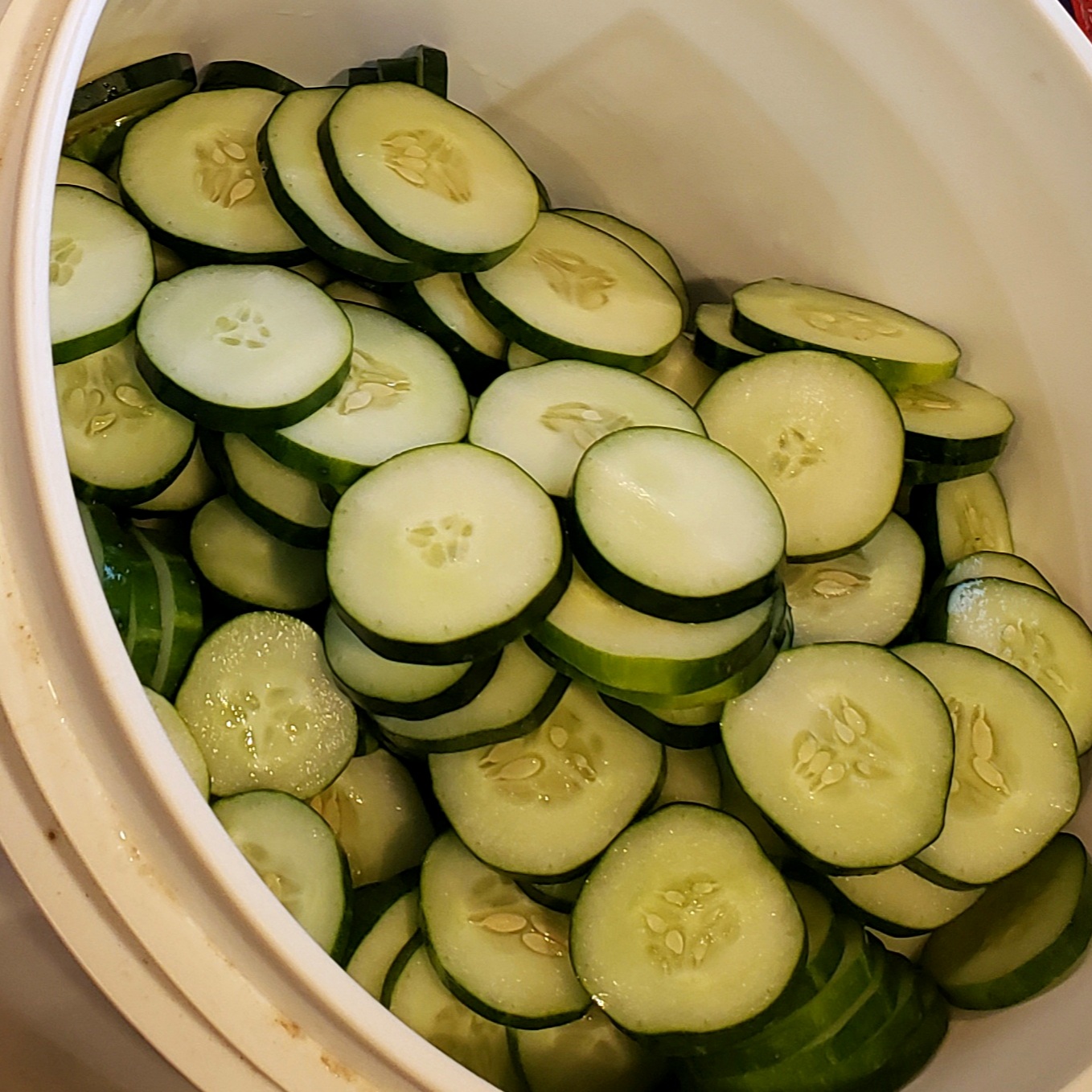Crunchy Pickles

So there is some important chemistry to consider when pickling sliced cucumbers. Pectin is a fiber substance in almost all veggies and fruits that helps to hold their cellular structure together. The rub is that pectin, when left to its own devices and exposed to the wrong temps and pH degrades pretty damn fast once you cut the ambilical cord (pick that fruit/veggie). With no live source attached to maintain the pectin, you get cellular degredation primarily as a function of temperature and pH.
Thus, pickling was discovered as a way to stop this evil pectin process. Vinegar, which is acetic acid (or lactic acid as produced in a lactofermentation pickling process) lowers the pH and defends against this pectin degredation that mushes everything up.
But there is another amazing chemistry inspired intervention that can stabilize pectin without lowering pH or temp.
Add some lime (calcium hydroxide).
Josh will be able to tell you all about how calcium (non-food grade lime) affects concrete under different conditions. But whaddabout its effect on cucumbers?
Well, it so happens that the calcium in lime happily binds to pectin to form calcium pectate. This is awesome, because calcium pectate is exceptionally stable in a cucumber, and helps to provide snap and crunch and everything we love about pickles. An overnight soak encourages this reaction.
So, if its so easy, why doesn’t everybody just lime the fuck out of their cucumbers instead of producing all those lame soggy crappy versions?
Well, chemistry again comes into play. It so happens that low pH is important when storing pickles. Like life saving important. Botulism (y’all know that word) is a killer bacteria, and if you don’t keep ya pickles below 4.6 pH, the spores are resistant to being killed by the typical water bath canning process. So who cares? What does this have to do with lime?
Lime (calcium hydroxide) is ALKALINE. If you remember your college chemstry class, alkaline neutralizes acid and increases pH!
So, since the general populace is considered DUFUS class intellect by the gov’mint…they have been recommending against using pickling lime for canning in these last decades. Apparently, “some” peeps don’t wash the excess lime off their cucumbers before canning (as clearly instructed) and so the excess hydroxide ions find their nearest acid and eliminate them, driving up the pH.
This leaves a quite favorable temp (when kept in the pantry and not the fridge) and high pH environment for botulism spores to do their thing, which can pretty much kill the entire unsuspecting homestead canner’s family after opening a jar to share at lunch.
So, should we really fear pickling lime and forego the benefits it brings to pickle crunch and just eat soggy pickles for safety sake? Hell no. We simply must apply our chemistry informed brains and rinse our limed cucumbers properly before brining, and then test the brine pH to confirm we are good. (Or just keep the damn pickles in the fridge).
I am totally into learning ways to make a cruchier and snappier pickle! The base recipe I used for garlic dills comes from Serious Eats website, but was modified slightly by adding the lime soak and rinse routine for 3.5 gallons of pickle slices and then adding just pickle crisp to the jars for the next 1.5 gallons. Also — I added mustard seed to the jars and will probably add celery seed as well next time. I also find that apple cider vinegar is overpowering flavor, so used about 80% white vinegar – 20% apple cider vinegar. Directions for the base recipe are at the link.
https://www.seriouseats.com/recipes/2011/08/garlic-dill-pickles.html
Directions for the lime soak and pickle crisp are on the packages of these products when you buy from the store (I used Ms. Wages picking lime with 12 hour soak and 3 one hour soak/rinse cycles before adding brine. Ball pickle crisp for the other type at the recommended rate per quart). Taste test after 3 days says I would use a slightly higher ratio of salt to vinegar and probably crush the garlic cloves instead of keeping whole.
- 2 quart kirby cucumbers (approximately 3 pounds)
- 1 1/4 cups white vinegar
- 1/4 cup apple cider vinegar
- 1 1/2 cups filtered water
- 2 tablespoons pickling salt
- 8 garlic cloves, peeled
- 4 teaspoons dill seed
- 2 teaspoons black peppercorns
- 1 teaspoon red chili flakes
- 1 teaspoon mustard seed
- 1 teaspoon celery seed

One thought on Crunchy Pickles
Of course, there is also a product out there called “pickle crisp” which also adds calcium to a canned product to promote this chemical reaction with pectin. Pickle crisp is simply food grade calcium chloride (rather than lime which is calcium hydroxide). With pickle crisp, when the calcium ions disassociate with the chloride ions in solution — you get something that lowers pH rather than raises it. No soaking, no reaction that raises pH — all happy…
I’m just not so sure it works as good to bind with pectin after the brine (with lots of sodium ions and chloride ions and acetic acid and everything) is already surrounding the cucumbers. The lime soak is done in water only, and binds with the pectin before all these other guys show up to the program.
So I have an experiment going — 3.5 gallons of pickles that were limed against 1.5 gallons that were canned with pickle crisp added directly to the jars. The jury is out (and will vote in a few weeks to see which works better and tastes better).